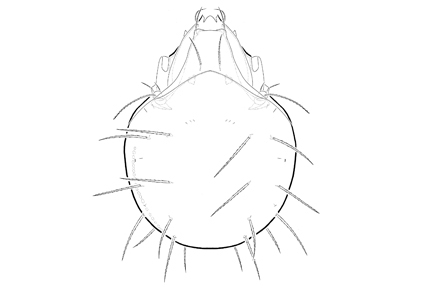Abstract
Three new species of Ceratorchestes (Ceratorchestes) (Oribatida, Peloppiidae)—C. (C.) tripartitus sp. nov., C. (C.) duocornutus sp. nov. and C. (C.) truncatus sp. nov.—are described, based on adults collected from leaf litter in northern Venezuela. Ceratorchestes (Paraceratorchestes) melzeri is recorded for the first time from Venezuela. An identification key, distribution and habitat to the known species of Ceratorchestes are provided.
References
- Balogh, J. & Mahunka, S. (1969a) The scientific results of the Hungarian soil zoological expeditions to South America. 10. Acari: oribatids, collected by the second expedition. I. Acta Zoologica Academiae Scientiarum Hungaricae, 15, 1–21.
- Balogh, J. & Mahunka, S. (1969b) The zoological results of the Hungarian soil zoological expeditions to South America. 11. Acari: oribatids from the material of the second expedition, II. Opuscula Zoologica Budapest, 9, 31–69.
- Behan-Pelletier, V.M., Paoletti, M.G., Bissett, B. & Stinner, B.R. (1993) Oribatid mites of forest habitats in northern Venezuela. Tropical Zoology, Special Issue 1, 39–54.
- Călugăr, M. (1990) Oribátidos nuevos de Venezuela (Acari, Oribatida). Boletin de la Sociedad Venezolana Espeleologia, 24, 15–20.
- De Moraes, J., Franklin, E., de Morais, J.W. & de Pereira de Souza, J.L. (2011) Species diversity of edaphic mites (Acari: Oribatida) and effects of topography, soil properties and litter gradients on their qualitative and quantitative composition in 64 km2 of forest in Amazonia. Experimental and Applied Acarology, 55, 39–63. https://doi.org/10.1007/s10493-011-9451-7
- Ermilov, S.G. (2024) Additions to the oribatid mite (Acari, Oribatida) fauna of Guatemala, with description of a new species of Pergalumna. Persian Journal of Acarology, 13, 361–373. https://doi.org/10.22073/pja.v13i3.85509
- Ermilov, S.G. & Kalúz, S. (2012) The oribatid mite genus Ceratorchestes (Acari: Oribatida: Peloppiidae). Acarologia, 52, 165–172. https://doi.org/10.1051/acarologia/20122046
- Ermilov, S.G. & Friedrich, S. (2017) New faunistic and taxonomic data on oribatid mites (Acari, Oribatida) of Peru. Acarina, 25, 3–13. https://doi.org/10.21684/0132-8077-2017-25-1-3-13
- Ermilov, S.G., Friedrich, S. & Kontschán, J. (2016) Contribution to the knowledge of the oribatid mite genus Ceratorchestes (Acari, Oribatida, Peloppiidae). Systematic and Applied Acarology, 21, 800–812. https://doi.org/10.11158/saa.21.6.7
- Franklin, E., Santos, E.M.R. & Albuquerque, M.I.C. (2006) Diversity and distribution of oribatid mites (Acari: Oribatida) in a lowland rain forest in Peru and in several environments of the Brazilians States of Amazonas, Rondônia, Roraima and Pará. Brazilian Journal of Biology, 66, 999–1020. https://doi.org/10.1590/s1519-69842006000600007
- Iglesias, R. & Palacios-Vargas, J.G. (2023) New contributions on oribatids (Acari: Oribatei) from Pozo La Escondida, Cerro Grande, Colima, Mex. Mundos Subterraneos, 32–33, 17–25.
- Mahunka, S. (1982) Neue und interessante Milben aus dem Genfer Museum XLIV. Oribatida Americana 5: Costa Rica (Acari). Archives des Sciences, 35, 179–193. https://doi.org/10.5962/bhl.part.82450
- Mahunka, S. (1983) Neue und interessante Milben aus dem Genfer Museum XLV. Oribatida Americana 6: Mexico II (Acari). Revue suisse de Zoologie, 90, 269–298. https://doi.org/10.5962/bhl.part.81976
- Maraun, M., Illig, J., Krashevska, V., Norton, R.A. & Scheu, S. (2008) Soil Fauna. In: Beck, E., Bendix, J., Kottke, I., Makeschin, F. & Mosandl, R. (Eds.), Gradients in a tropical mountain ecosystem of Ecuador. Ecological studies. Springer, Berlin and Heidelberg, pp. 181–192. https://doi.org/10.1007/978-3-540-73526-7_18
- Marian, F., Sandmann, D., Krashevska, V., Maraun, M. & Scheu, S. (2018) Altitude and decomposition stage rather than litter origin structure soil microarthropod communities in tropical montane rainforests. Soil Biology and Biochemistry, 125, 263–274. https://doi.org/10.1016/j.soilbio.2018.07.017
- Maraun, M., Fronczek, S., Marian, F., Sandmann, D. & Scheu, S. (2013) More sex at higher altitudes: Changes in the frequency of parthenogenesis in oribatid mites in tropical montane rain forests. Pedobiologia, 56, 185–190. https://doi.org/10.1016/j.pedobi.2013.07.001
- Norton, R.A. (1977) A review of F. Grandjean's system of leg chaetotaxy in the Oribatei (Acari) and its application to the family Damaeidae. In: Dindal, D.L. (Ed.), Biology of oribatid mites. SUNY College of Environmental Science and Forestry, Syracuse, pp. 33–61.
- Norton, R.A. & Behan-Pelletier, V.M. (2009) Chapter 15. Suborder Oribatida. In: Krantz, G.W. & Walter, D.E. (Eds.), A Manual of Acarology. Texas Tech University Press, Lubbock, Texas, pp. 430–564.
- Salazar-Fillippo, A.A. & Miko, L. (2022) Checklist of the oribatid mites (Acari: Oribatida) of the Republic of Colombia. Zootaxa, 5087 (1), 35–58. https://doi.org/10.11646/zootaxa.5087.1.2
- Sánchez-Galindo, L.M., Camenzind, T., Maraun, M. & Scheu, S. (2019) Impacts of core rotation, defaunation and nitrogen addition on arbuscular mycorrhizal fungi, microorganisms and microarthropods in a tropical montane rainforest. Tropical Ecology, 60, 350–361. https://doi.org/10.1007/s42965-019-00038-9
- Schatz, H. (2006) Catalogue of known oribatid mite species (Acari Oribatida) from the Central American landbridge (First part). Tropical Zoology, 19, 209–288.
- Subías, L.S. (2022) Listado sistemático, sinonímico y biogeográfico de los ácaros oribátidos (Acariformes: Oribatida) del mundo (excepto fósiles). Monografías Electrónicas Sociedad Entomológica Aragonesa, 12, 1–538.
- Subías, L.S. (2024) Listado sistemático, sinonímico y biogeográfico de los ácaros oribátidos (Acariformes: Oribatida) del mundo (excepto fósiles), 19ª actualización, 1–545. Available from: http://bba.bioucm.es/cont/docs/RO_1.pdf (accessed January 2024)
- Subías, L.S. & Shtanchaeva, U.Ya. (2021) Contribución al conocimiento de la distribución de los ácaros oribátidos (Acari, Oribatida) tropicales. Revista Ibérica de Aracnología, 38, 69–80.
- Subias, L.S., Zaballos, J.P., Banda, E., Fontal-Cazalla, F. & Nieves-Aldrey, J.L. (2004) Ácaros oribátidos (Acari, Oribatei) del Parque Nacional de la isla de Coiba, Panamá. Revista de Biología Tropical, 52, 85–95. https://doi.org/10.15517/rbt.v52i1.14755
- Villagomez, F., Iglesias, R. & Palacios-Vargas, J.G. (2017) Los ácaros oribátidos (Acari: Oribatei) de los estratos edáficos y arbóreos de la selva alta perennifolia de los Tuxtlas, Veracruz. Entomología Mexicana, 4, 28–34.
- Villagomez, F., Palacios-Vargas, J.G., Castano-Meneses, G. & Castellanos-Vargas, I. (2019) Effect of tree identity, temporal variation and edaphic parameters on the structure of the edaphic community of oribatid mites in an evergreen tropical forest of Mexico. Applied Ecology and Environmental Research, 17, 14621–14639. https://doi.org/10.15666/aeer/1706_1462114639


